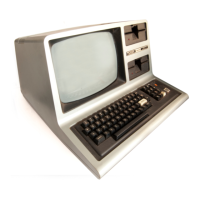4P THEORY OF OPERATION
5.1
CPU THEORY OF OPERATION
5.1.1
Introduction
Contained
in
the following paragraphs
is
a description of the
component parts of the Model4P CPU.
It
is
divided into the log-
ical
operational
functions
of
the
computer.
All
components
are
located
on
the Main CPU board inside the case housing. Refer
to
Section 3 for disassembly/assembly procedures.
5.1.2 Reset Circuit
(pin 9 of U126).
If
FAST
is
a logic low, the 20.2752 MHz
is
di-
vided by 10 which generates a 2.2752 MHz signal
If
FAST
is
a
logic high, the 20.2752 MHz
is
divided by 5 which generates a
4.05504 MHz signal. The CPU clock (PCLK)
is
fed through
an
active
pull-up
circuit
which
generates a
ful15-volt
swing
with
fast
rise and fall times required by the Z80A. U126. the 16R6A
PAL.
generates
all
symmetrical
output
signals
and
also
does
not
al-
low the PCLK output to short cycle or generate a low or high
pulse
under
110
nanoseconds
which
the
ZaOA
also
requires.
Refer
to
System Timing Fig. 5-2.
5.1.4.1 Video Timing
'This
is the state to be wriften to latch U89. Signal
is
inverted
before being input to U127.
MOOSEL and
8064'
signals are used to select the desired
video mode.
8064'
controls which reference clock
is
used by
U127 and MOOSEL controls the single or double character
width mode. Refer to the following chart for selecting each
video
mode.
The PLL (NE564)
is
adjusted to oscillate at 12.672 MHz by the
luning capacitor C231. This 12.672 MHz clock
is
then divided
by
10 through U149 to generate a second 1.2672 MHz signal
whioh is fed to a second input of U148. The two 1.2672 MHz
signals
are
compared
internally
to
the
PLL
where
it
corrects
the
12.672 MHz output so
it
is
synchronized with the 20.2752 MHz
clock.
Video Mode
64 x 16
32 x 16
80
x24
40
x 24
MOOSEL
o
1
o
1
8064'
o
o
1
1
The video timing is controlled by a 1
OL8
PAL
(U127) and a four-
bit synchronous counter U128 (74LS161). These two ICs gen-
erate all the necessary timing signals for the four video modes:
64
x
16,
32 x 16,
80
x 24, and 40 x 24.
Two
reference clock sig-
nals
are
required
for
the
four
video modes. One reference
clock, the 10.1376 MHz signal (10M),
is
generated
by
U126 and
is
used by the
64
x 16 and
32
x 16 modes. The second refer-
ence clock
is
a 12.672 MHz (12M) signal which
is
generated by
a Phase Locked Loop (PLL) circuit and
is
used
by
the 80 x
24
and 40 x
24
modes. The PLL circuit consists of U147 (74LS93),
U148 (NE564 PLL), and U149 (74LS90). The original 20.2752
MHz clock
is
divided by
16
through U147 which generates a
1.2672 MHz signal. The output of U147 is reduced
in
amplitude
by
the voltage divider network R27 and R28 and the output
is
coupled
to
the reference input of U148 by C227.
The central processing unit (CPU) of the Model 4P microcom-
puter
is
a Z80A microprocessor. The Z80A is capaqle of run-
ning in either 2 MHz
or
4 MHz mode. The CPU controls all
functions
of
the
microcomputer
through
use
of
its
address
lines
(AO-A
15), data lines
(00-07),
and control lines
(lMl,
/IOREQ,
/RO,
/WR, /MREQ, and /RFSH). The address lines
(AO-A
15)
are
buffered to other ICs through two 74LS244s (U68 and U26)
which are enabled all the time with their enables pulled to GNO.
The control lines are buffered to other ICs through a 74F04
(U86). The data lines
(00-07)
are buffered through a bi-direc-
tionaI 74LS245 (U71) which
is
enabled by BUSEW and the di-
rection
is
controlled by BUSOIW.
5.1.3 CPU
The
main
timing
reference
of
the
microcomputer,
with
the
ex-
ception of the FOC circuit, comes from a 20.2752 MHz Crystal
Oscillator (Y1). This reference
is
divided and used for gener-
ating all necessary timing for the CPU, video circuit, and
RS-
232-C circuit. The output of the crystal oscillator
is
filtered by a
ferrifte bead (FB5), 470 ohm resistor (R46), and a
68
pf
ca-
pacitor (C242). After being filtered,
it
is
fed into U126, a 16R6A
PAL
(Programmable Array Logic), where
it
is divided by 2 to
generate a 10.1376 MHz signal (10M) for the
64
X
16
video dis-
play. U126 divides the 20.2752 MHz
by
4 to generate a 5.0688
MHz signal (RS232CLK) for the baud rate generator
in
the RS-
232-C circuit. The
CPU
clock
is
also generated by U126 which
can
be
either 2 or 4 MHz depending
on
the state of
FAST
input
The Model 4P reset circuit provides the neccessary reset
pulses
to
all
circuits
during
power
up
and
reset
operations.
R25
and C218 provide a time constant which holds the input of
U121
low during power-up. This allows power to be stable to
all
cir-
cuits before the
RESEr
and RESETsignals are applied. When
C218 charges to a logic high, the output of
U121
triggers the
input of a retriggerable one-shot mullivibrator
(Ul).
Ul
outputs
a pulse with
an
approximate width of
70
microsecs. When the
reset switch is pressed on the front panel, this discharges C218
and
holds the input of
U121
low until the switch is released.
On
release of the switch, C218 again charges up, triggering
U121
and
U1
to
reset
the
microcomputer.
5.1.4 System Timing
23

